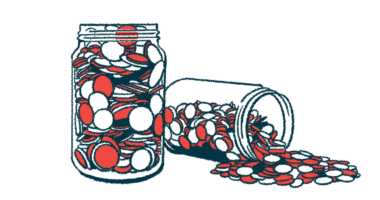Scientists in Parkinson’s are finalists for European Inventor Award 2024
French team developed dosing pump to deliver dopamine directly to brain

The European Inventor Award 2024 has named as finalists a French husband-and-wife team of scientists who developed a dosing pump that allows for direct delivery of dopamine to the brain in people with Parkinson’s disease.
The use of dopamine is expected to help reduce symptoms and so-called off episodes, or periods between medication doses when symptoms are not well-controlled, in Parkinson’s patients.
The small pump is connected to a catheter designed to be internally implanted into a patient’s brain. It allows the patient to then self-administer dopamine using the pump when needed, making the quantities of the medications delivered more consistent.
“It’s like giving a flower its precious water drop by drop all the time instead of drowning it,” David Devos, MD, PhD, professor at the University of Lille, in France, and one of the leaders of the team, said in a news story from the nonprofit Parkinson’s Europe. The project also is led by Caroline Moreau, MD, PhD, a professor at Lille University, and Devos’ wife.
The duo also are contenders for the Popular Inventor Award, chosen by the general public. Voting is open until early July, and is done online. The awards winners will be announced in a ceremony in July in Malta, which will be live-streamed to the public.
Husband-wife duo up for Popular Inventor and European Inventor Award
With the pump, dopamine is provided in an anaerobic, or without oxygen, solution, called A-dopamine. The scientist team developed A-dopamine after previous research found that dopamine was ineffective when exposed to oxygen. Dopamine is a signaling molecule that neurons, or nerve cells, use to communicate. The pump’s dopamine supply is refilled every one to two weeks.
“We are convinced that A-dopamine will be a groundbreaking therapeutic weapon administered on a long run to patients…. That said, we have to remain humble because we are not curing Parkinson’s disease,” Devos said.
Parkinson’s is caused by the dysfunction and death of dopaminergic neurons, which are nerve cells in the brain responsible for producing dopamine. The loss of these neurons causes problems with nerve signaling, ultimately leading to the disease’s symptoms.
Levodopa, the mainstay of Parkinson’s treatment, works to replace the lost dopamine. However, as the disease progresses, patients will require greater and more frequent dosing to control their symptoms, resulting in frequent fluctuations in patients’ exposure to the medication.
Moreover, individuals with the neurodegenerative disease may experience periods between doses when symptoms are not well controlled, referred to as off episodes. They also may experience uncontrolled motor movements, known as dyskinesia.
The husband-wife team created the A-dopamine solution by replacing the oxygen with dioxide and nitrogen in an anaerobic chamber, allowing it to then be directly administered to the brain. The catheter is precisely implanted in the brain by neurosurgeons, using imaging and robotic machinery.
We are convinced that A-dopamine will be a groundbreaking therapeutic weapon administered on a long run to patients…. That said, we have to remain humble because we are not curing Parkinson’s disease.
Testing of the device began in 2020 in a Phase 1/2 trial (NCT04332276) that is expected to be completed in June. The trial included Parkinson’s patients with complications associated with levodopa treatment, such as at least two hours of off periods and/or one hour of dyskinesia daily, despite oral dopaminergic treatments.
Patients were assigned to receive either A-dopamine using the delivery pump, or oral dopaminergic treatments with a placebo pump.
In the Phase 1 part of the trial, the A-dopamine dose was increased to a maximum of 0.25 mg per hour during daytime, corresponding to 4.5 mg a day, up to a target dose between 30 and 87 mg per day, depending on treatment tolerance and efficacy.
The treatment was maintained at the minimum effective dose, for 30 days, in the Phase 2 part of the trial.
“Treatment with A-dopamine considerably reduced the periods during which patients [had] both dopamine-dependent tremor, slowness, pain, and difficulties in walking and communicating, as well as levodopa-induced abnormal symptoms … limiting their autonomy and quality of life,” Devos said.
“All the treated patients wished to continue the treatment over the very long term,” Devos added.
If the trial’s results are positive, the researchers will start a Phase 3 clinical trial they hope could lead to approval of the use of the pump and A-dopamine as a Parkinson’s treatment in Europe and the U.S.







